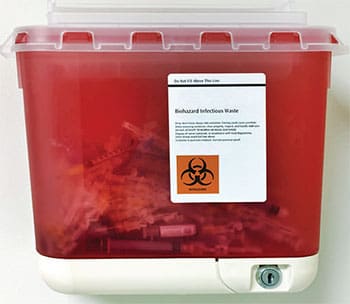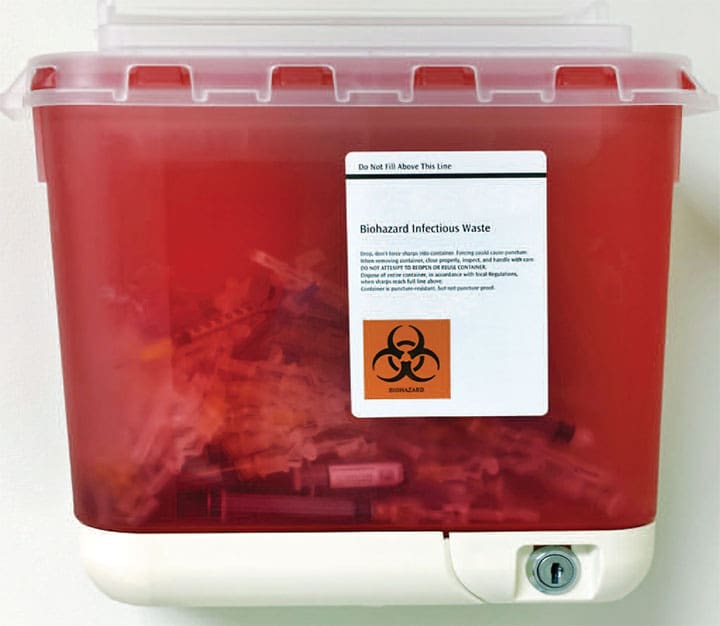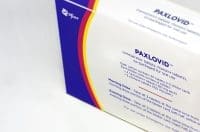Your involvement in safety programs and device evaluation and selection protects everyone.
Takeaways:
- Increases in incidence of diabetes can result in increasing incidence of sharps injuries for nurses delivering care.
- Insulin needles are the most frequent needle type causing needlestick injuries in healthcare.
- When injecting patients with insulin, evaluate best and safest options for delivery including syringes and/or pens with safety features, as well as appropriate sharps disposal containers.
By Amber Hogan Mitchell, DrPH, MPH, CPH, and Ginger B. Parker, MBA
 This is the second installment in a two-part series on needlestick injuries related to insulin injection. You can read the first article at myamericannurse.com/37706.
This is the second installment in a two-part series on needlestick injuries related to insulin injection. You can read the first article at myamericannurse.com/37706.
Because the incidence of type 2 diabetes has quadrupled since 1980, the use of syringe and pen needles for medication delivery has grown exponentially, resulting in an unacceptable risk of contaminated needlestick injury to nurses.
In part one of this series, we provided detailed information about the latest sharps injury incident data from International Safety Center’s Exposure Prevention Information Network (EPINet®), which indicates that about 20% of all syringe needlestick injuries result from insulin needles. In this article, we’ll use that data as the foundation for helping you and your organization build or revamp programs and action plans.
Shoring up your sharps safety plan
As it relates to sharps injuries and needlesticks from devices used to diagnose, treat, and manage diabetes, the Occupational Safety and Health Administration (OSHA) Bloodborne Pathogens standard requires the following steps:
 Exposure determination. Include steps to identify employees at risk for exposure to blood or body fluids. The assessment and documentation should include job classifications in which all employees are at risk for exposure during the course of their jobs; include not just clinical personnel, but anyone who may have any kind of exposure. Also, list the tasks and procedures performed by the employees that may result in exposure. For example, staff nurses give injections and draw or test blood.
Exposure determination. Include steps to identify employees at risk for exposure to blood or body fluids. The assessment and documentation should include job classifications in which all employees are at risk for exposure during the course of their jobs; include not just clinical personnel, but anyone who may have any kind of exposure. Also, list the tasks and procedures performed by the employees that may result in exposure. For example, staff nurses give injections and draw or test blood.
 Written exposure control plan. Update this plan every year and as devices, procedures, or controls change. It must include the exposure determination for access by employees and provide information on safety-device evaluation and selection by frontline nonmanagerial employees.
Written exposure control plan. Update this plan every year and as devices, procedures, or controls change. It must include the exposure determination for access by employees and provide information on safety-device evaluation and selection by frontline nonmanagerial employees.
 Engineering and work practice controls. Include the evaluation and selection of safer medical devices, such as needles with safety-engineered features and pen needles with safety features on both front (patient) and back (device) ends. More than 50% of all injuries occur from devices with safety features that haven’t been activated, so work practice controls should dictate the importance of not just having a safer device, but activating safety features to protect employees and anyone downstream.
Engineering and work practice controls. Include the evaluation and selection of safer medical devices, such as needles with safety-engineered features and pen needles with safety features on both front (patient) and back (device) ends. More than 50% of all injuries occur from devices with safety features that haven’t been activated, so work practice controls should dictate the importance of not just having a safer device, but activating safety features to protect employees and anyone downstream.
 Regulated waste. Nearly 25% of all sharps injuries occur downstream, so safe disposal is critical for injury prevention. Regulation requirements include safe sharps disposal and parameters for containers (they should be leak-proof, color-coded, and labeled). Don’t overfill containers and make sure your facility performs regular fill status “rounds.” Some facilities that give many insulin injections use small portable sharps containers in addition to wall-mounted ones. Determine which types of containers are best based on the devices being used.
Regulated waste. Nearly 25% of all sharps injuries occur downstream, so safe disposal is critical for injury prevention. Regulation requirements include safe sharps disposal and parameters for containers (they should be leak-proof, color-coded, and labeled). Don’t overfill containers and make sure your facility performs regular fill status “rounds.” Some facilities that give many insulin injections use small portable sharps containers in addition to wall-mounted ones. Determine which types of containers are best based on the devices being used.
 Hepatitis B vaccination and postexposure evaluation and follow-up. People with diabetes are at increased risk of developing hepatitis B virus (HBV), so include your organization’s HBV vaccination plans and postinjury follow-up in your sharps safety plan. Many employee health offices and clinics have limited hours of operation, which can hinder immediate postinjury care during night and weekend shifts; in ambulatory or long-term care facilities, there may be no formal health office at all. If your organization uses an urgent care or emergency department to triage workers with injuries, eliminate any deterrents to immediate, accessible postexposure care.
Hepatitis B vaccination and postexposure evaluation and follow-up. People with diabetes are at increased risk of developing hepatitis B virus (HBV), so include your organization’s HBV vaccination plans and postinjury follow-up in your sharps safety plan. Many employee health offices and clinics have limited hours of operation, which can hinder immediate postinjury care during night and weekend shifts; in ambulatory or long-term care facilities, there may be no formal health office at all. If your organization uses an urgent care or emergency department to triage workers with injuries, eliminate any deterrents to immediate, accessible postexposure care.
 Communication of hazards to employees. In addition to providing access to the exposure control plan, share information and offer training on safe and effective device use, safety feature activation, and disposal. Care of people with diabetes involves many types of devices, so ensuring the confidence of everyone who’s responsible for providing that care is crucial to connecting the puzzle pieces of engineering and work practice controls.
Communication of hazards to employees. In addition to providing access to the exposure control plan, share information and offer training on safe and effective device use, safety feature activation, and disposal. Care of people with diabetes involves many types of devices, so ensuring the confidence of everyone who’s responsible for providing that care is crucial to connecting the puzzle pieces of engineering and work practice controls.

 Recordkeeping. The Bloodborne Pathogens standard requires employers to keep a sharps injury log that includes device type, device brand name, work area where injury occurred, and a brief description of how the incident happened. However, as we do at EPINet, you can include even more information, such as professional role, use of safer device, activation of safety feature, and device purpose. More detail helps everyone work together to prevent injuries. OSHA also requires that employers submit their OSHA 300 and 301 logs electronically. Because these logs include sharps injuries, instituting quality recordkeeping systems that serve double duty—compliance with OSHA regulations and as injury investigation and prevention tools—is a good idea.
Recordkeeping. The Bloodborne Pathogens standard requires employers to keep a sharps injury log that includes device type, device brand name, work area where injury occurred, and a brief description of how the incident happened. However, as we do at EPINet, you can include even more information, such as professional role, use of safer device, activation of safety feature, and device purpose. More detail helps everyone work together to prevent injuries. OSHA also requires that employers submit their OSHA 300 and 301 logs electronically. Because these logs include sharps injuries, instituting quality recordkeeping systems that serve double duty—compliance with OSHA regulations and as injury investigation and prevention tools—is a good idea.
 New device evaluation. Because many new technologies are available for safer insulin delivery, a formal device evaluation program is part of shoring up your safety plan. Remember, OSHA requires that frontline, nonmanagerial employees participate in safer device evaluation and selection, so formalizing your program will help. You may want to create a checklist with design features for devices used for insulin delivery. (See Safer device checklist.) You can do something similar for other devices used for patients with diabetes, including blood glucose testing.
New device evaluation. Because many new technologies are available for safer insulin delivery, a formal device evaluation program is part of shoring up your safety plan. Remember, OSHA requires that frontline, nonmanagerial employees participate in safer device evaluation and selection, so formalizing your program will help. You may want to create a checklist with design features for devices used for insulin delivery. (See Safer device checklist.) You can do something similar for other devices used for patients with diabetes, including blood glucose testing.
Changing public health landscape
Ultimately, as the public health landscape changes, affecting the types of patients we see and the care needed, we must assess the impact on occupational health and safety. In the case of more patients with diabetes, that means creating policies and practices that protect patients and nurses from inadvertent harm.
The authors work at the International Safety Center (InternationalSafetyCenter.org). Amber Hogan Mitchell is president and executive director. Ginger B. Parker is vice president and chief information officer.
Selected references
Centers for Disease Control and Prevention. Diabetes public health resource: Crude and age-adjusted percentage of adults with diabetes using any diabetes medication, United States, 1997-2011.
Centers for Disease Control and Prevention. National Diabetes Statistics Report, 2017: Estimates of Diabetes and Its Burden in the United States.
United States Department of Labor. Occupational Safety and Health Administration. OSHA 29 CFR 1910.1030 Occupational Exposure to Bloodborne Pathogens.
World Health Organization. Global Report on Diabetes. 2016.
ant2-Sharps 2-118


















